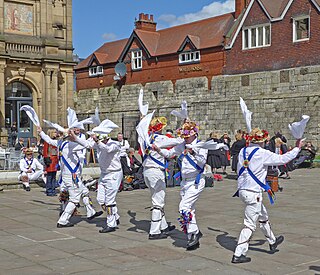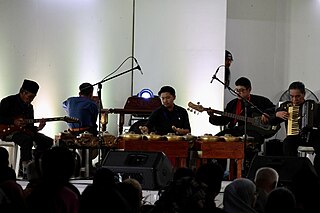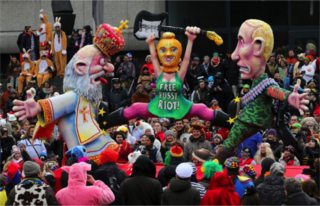
A folk dance is a dance that reflects the life of the people of a certain country or region. Not all ethnic dances are folk dances. For example, ritual dances or dances of ritual origin are not considered to be folk dances. Ritual dances are usually called "religious dances" because of their purpose.

Morris dancing is a form of English folk dance. It is based on rhythmic stepping and the execution of choreographed figures by a group of dancers in costume, usually wearing bell pads on their shins and/or shoes. A band or single musician, also costumed, will accompany them. Sticks, swords, handkerchiefs, and a variety of other implements may be wielded by the dancers.
The Netherlands has multiple musical traditions. Contemporary Dutch popular music is heavily influenced by music styles that emerged in the 1950s, in the United Kingdom and United States. The style is sung in both Dutch and English. Some of the latter exponents, such as Golden Earring and Shocking Blue, have attained worldwide fame.

Clogs are a type of footwear made in part or completely from wood. Used in many parts of the world, their forms can vary by culture, but often remained unchanged for centuries within a culture.

Step dance is a generic term for dance styles in which footwork is considered to be the most important part of the dance and limb movements and styling are either restricted or considered irrelevant.

Brunei is a southeast Asian country located on Borneo between the states of Sabah and Sarawak which are part of Malaysia. There is a wide array of native folk music, and dance. Brunei shares some Cultural perspectives and links with the countries of Southeast Asia such as Malaysia, Singapore, Indonesia, Thailand, and the Philippines. The strong Islamic influence means that dance performances and music are somewhat restricted.

Clog dancing is a form of step dance characterised by the wearing of inflexible, wooden soled clogs. Clog dancing developed into differing intricate forms both in Wales and also in the North of England. Welsh clog dancing mainly originates from various slate mines where workers would compete against each other during work breaks. Northern English traditional clog dancing originates from Lancashire, Yorkshire, County Durham, Northumberland and the Lake District.
{{Pun Punjabi dances are an array of folk and religious dances of the Punjabi people indigenous to the Punjab region, straddling the border of India and Pakistan. The style of Punjabi dances ranges from very high energy to slow and reserved, and there are specific styles for men and women.

Lithuanian folk songs are often noted for not only their mythological content but also their relating historical events.

Ukrainian folklore is the folk tradition which has developed in Ukraine and among ethnic Ukrainians. The earliest examples of folklore found in Ukraine is the layer of pan-Slavic folklore that dates back to the ancient Slavic mythology of the Eastern Slavs. Gradually, Ukrainians developed a layer of their own distinct folk culture. Folklore has been an important tool in defining and retaining a cultural distinctiveness in Ukraine in the face of strong assimilatory pressures from neighboring lands.
The Philippines is home to several folk dances such as Tinikling, Pandanggo, Cariñosa, and Subli. Dance has integrated itself in Philippine society over the course of many years and is imbedded in Philippine culture.
Sean-nós dance in America has its roots in Irish culture, but may be practiced differently from how it is danced in Ireland. When Irish people emigrated to America in great numbers during the early American Colonial period, or when escaping The Troubles in Ireland, they brought their dance culture with them. One of the many forms of Irish dance is sean-nós dance, which is an informal, spontaneous, solo form of dance. Sean-nós dance has both modified, and in turn been modified by, similar forms of traditional vernacular solo dance in America.
Sean-nós dance is an older style of traditional solo Irish dance. It is a casual dance form, as opposed to the more formal and competition-oriented form of Irish stepdance.

Bhangra is a type of traditional folk dance of Punjab area of the Indian subcontinent. It is done in the season of harvesting. According to Manuel (2001), bhangra is especially associated with the vernal Vaisakhi festival, performed during harvest season between April and the first quarter of May.

A klomp is a whole-foot clog from the Netherlands. Along with tulips and windmills, they are strongly associated with the country and are considered to be a national symbol of the Netherlands.

A British clog is a wooden-soled clog from Great Britain. The uppers are typically leather, and many variations exist in style and fastening.

Czech folklore is the folk tradition which has developed among the Czech people over a number of centuries. Czech folklore was influenced by a mix of Christian and pagan customs. Nowadays it is preserved and kept alive by various folklore ensembles uniting members of all ages, from children to seniors, showing their talent during competitions, folklore festivals or other performances.

Carnival in the Netherlands is a festival held mainly in the Southern and Eastern regions of the Netherlands with an emphasis on role-reversal and the suspension of social norms, as part of celebrations of Carnival. The feast was assimilated by the Catholic Church, taking elements from ancient pagan spring festivals and is celebrated in the three days preceding the Christian holidays of Ash Wednesday and Lent.
Traditional dancing in the Netherlands is often called "Folkloristisch", sometimes "Boerendansen" ("farmer-dancing") or "Klompendansen". Wooden shoes are worn as an essential part of the traditional costume for Dutch clogging, or Klompendanskunst. Clogs for dancing are made lighter than the traditional 700-year-old design. The soles are made from ash wood, and the top part is cut lower by the ankle. Dancers create a rhythm by tapping the toes and heels on a wooden floor.

The Welsh stepdance or Welsh clog dance is a traditional Welsh form of dance involving clog shoes and percussive movement of the feet and athletic movements. It is typically done to Welsh traditional music and wearing traditional Welsh costume, but not always.













